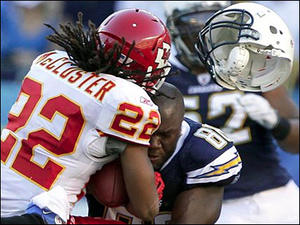Safe helmetsNFL in search of new helmets to reduce brain trauma
Researchers at the NFL’s Southern Impact Research Center are currently exploring ways to install sensors on helmets to measure the amount of head trauma players receive; league officials hope that the sensors can eventually be installed on all helmets to provide accurate data that can then be used to adjust game rules and construct better helmets that will reduce the number of concussions

Contact like this increases the number of football concussions // Source: komonews.com
Researchers at the NFL’s Southern Impact Research Center are currently exploring ways to install sensors on helmets to measure the amount of head trauma players receive.
League officials hope that the sensors can eventually be installed on all helmets to provide accurate data that can then be used to adjust game rules and construct better helmets that will reduce the number of concussions.
“The purpose is to find out in real time out on the field, as opposed to in a laboratory like we’re doing here, what types of impacts players take,” says Kevin Guskiewicz, director of sports-related brain injury research at the University of North Carolina and a member of the NFL’s head, neck and spine committee.
To measure the impact of hits, helmets as well as mouth guards have been outfitted with sensors. Researchers are still testing the system, but hope to install them on a sample of players in practice and play.
“My hope is that we find we have valid instruments. We can then hopefully run a pilot project … in maybe five or six teams (about 180 players),” Guskiewicz said.
Guskiewicz hopes that the technology can be implemented in a pilot program within the next one to two seasons before it eventually goes league-wide as part of a broader study on head injuries.
Richard Ellenbogen, the co-chair of the NFL head, neck and spine committee, said the league seeks to understand why some players can receive massive blows to the head and remain uninjured, while others receive a “5G impact and they’re concussed.”
Before that can happen, Ellenbogen explains that researchers need to verify what the sensors are measuring.
Once we analyze the stuff, then we want to know, ‘OK, you get this impact and it equates with this neurologic outcome,’” said Ellenbogen, who is also a neurosurgeon at the University of Washington. “Then maybe we can go back to the Competition Committee and say, ‘Look, here’s the data, now you, the football experts, have to figure out how to try to alter the rules to fit this data maybe.’”
Ellenbogen and Guskiewicz agree that the helmets currently used in the NFL do a good job of preventing skull fractures and internal bleeding, but say that the leagues is always looking to find a helmet that can “help reduce the incidence and severity of concussions.”
Ellenbogen said, ”I don’t think there’s anything that will ever eliminate concussions,” but, “I’d like to see them go as low to zero as we possibly can.”
